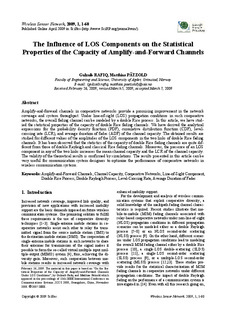The influence of LOS components on the statistical properties of the capacity of amplify-and-forward channels
Journal article, Peer reviewed
Permanent lenke
http://hdl.handle.net/11250/137653Utgivelsesdato
2009Metadata
Vis full innførselOriginalversjon
Rafiq, G., & Pätzold, M. (2009). The Influence of LOS Components on the Statistical Properties of the Capacity of Amplify-and-Forward Channels Wireless Sensor Network 1(1), 7-14. doi: 10.4236/wsn.2009.11002Sammendrag
Amplify-and-forward channels in cooperative networks provide a promising improvement in the network coverage and system throughput. Under line-of-sight (LOS) propagation conditions in such cooperative networks, the overall fading channel can be modeled by a double Rice process. In this article, we have stud-ied the statistical properties of the capacity of double Rice fading channels. We have derived the analytical expressions for the probability density function (PDF), cumulative distribution function (CDF), level- crossing rate (LCR), and average duration of fades (ADF) of the channel capacity. The obtained results are studied for different values of the amplitudes of the LOS components in the two links of double Rice fading channels. It has been observed that the statistics of the capacity of double Rice fading channels are quite dif-ferent from those of double Rayleigh and classical Rice fading channels. Moreover, the presence of an LOS component in any of the two links increases the mean channel capacity and the LCR of the channel capacity. The validity of the theoretical results is confirmed by simulations. The results presented in this article can be very useful for communication system designers to optimize the performance of cooperative networks in wireless communication systems.
Beskrivelse
Also available from publisher:
http://dx.doi.org/10.4236/wsn.2009.11002
